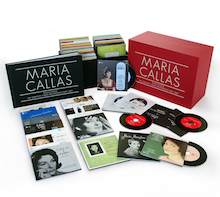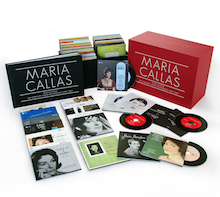
On Sept. 23 a newly remastered 69-CD box set of Maria Callas’ entire studio discography became available from Warner Classics. Some of the components of the box, including, most notably, the 1953 Tosca, one of the greatest complete opera recordings ever made, the 1954 monaural Norma, and the 1964 stereo Carmen, were made available as individual releases on September 23, with the remaining individual components scheduled for release on Oct. 21 and Nov. 11. There will even be a single “Pure” CD compilation (Sept. 23) and vinyl compilation (Oct. 21).
Why, you may ask, do we have yet another digital remastering of the most important soprano of the last century, when the exact same recordings were released in an earlier CD box set. Because the new remastering is a high-resolution (24-bit/96 kHz sampling rate) advance that moves us far closer to the sound of the original analog masters. In addition, the three sound engineers responsible for the new remasterings have accessed the best sources available — in most cases, the ¼-inch master tapes — and dispensed with all the noise-cancelling filtering, additional reverb, and other interventionist techniques that muddied up the sound of the last CD issues.
Judging from the before / after comparison CD that Warner Classics provided to the press, the remastering’s long-overdue restoration of both the natural treble edge to Callas’ voice and high frequency extension of the orchestra, and its palpably greater richness and body, delivers far more detailed and truthful sound. The new remasters sound as though a previously clouded window on Callas’ artistry has been scrubbed clean.
Most exciting for us audiophiles is that, along with the individual CD releases, high-resolution 24/96 downloads of Callas’ entire commercial discography will become available on HDTracks (HDTracks.com). Expect them to sound vastly superior to the “Mastered for iTunes” downloads. They’ll cost more, but when downloaded via a wired connection — wireless downloads compromise sound quality — they’ll deliver sound that should get us quite close to, and in some cases surpass, the sound of the original LPs. These remasterings promise to give us far more of what the original engineers hoped we would hear, and move us as close to the heart of Callas’ revolutionary artistry as we’re ever likely to get. If the recorded era of opera is often divided into B.C. (Before Callas) and A.C. (After Callas), these new 24/96 remasters are the equivalent of S.A.D. (Stone Age Digital) transformed into N.A.D. (New Age Digital).

